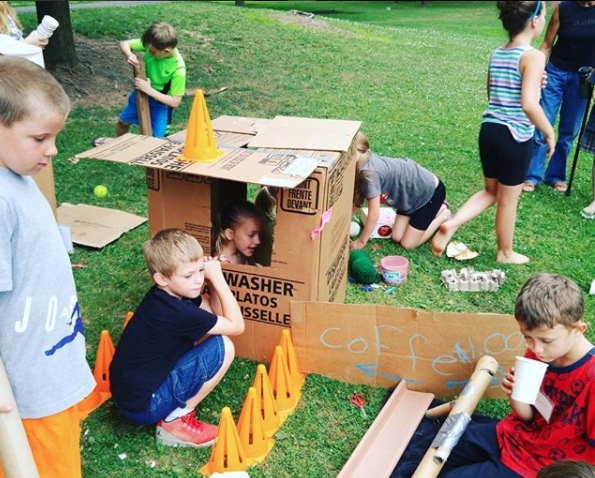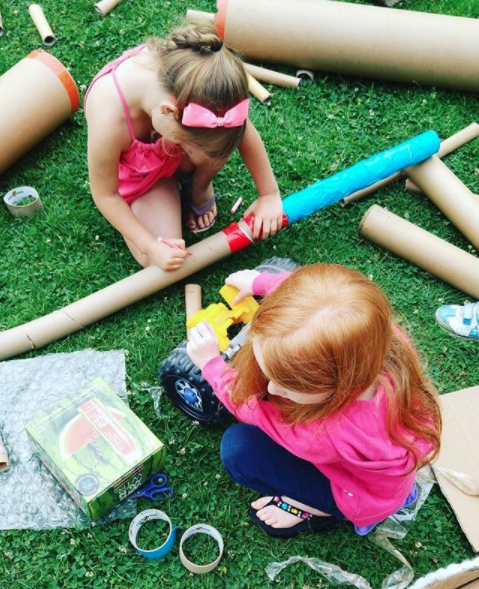With how many of those treasured toys from Christmas are your children still passionately playing? Often it's the boxes and string, tape, and markers that get more attention and interest than the expensive dolls and fiddly gadgets. But many caregivers are resistant to the free play that expert Elizabeth Marcello calls essential to a child's learning. Founder of Lycoming Pop-Up Play, a non-profit in Williamsport, PA, dedicated to fostering child-directed, open-ended play for all kids regardless of income or access, Marcello shares insider tips for fostering free and meaningful play in your child's life that will last long after the toys.
1) Why is free play important?
Whether you use the term "free play", "child-led play", "child-directed play", or something else, the underlying concept is simple--it's about letting children PLAY!
The term "free," when used in relation to play, seems to spark in my mind that a child has reign over her play. That is, she chooses her materials or actions, she chooses who to play with (and that may be no one), and she chooses when to begin and end her play. This type of play has positive benefits for social, emotional, cognitive, and physical development in children. It gives children an opportunity to engage in healthy risks, to learn to work with others, and to resolve their own problems.
Unfortunately, what we see a lot of today is not freedom, but "teacher/parent-directed play." This type of play is often less messy and often has an end goal that makes sense to the teacher, caregiver, or parent. While still considered play, it often limits a child's creativity, problem-solving skills, and cooperative skills.
If you take a look at current statistics on depression, anxiety, obesity, and over-scheduling in children, they are daunting. More children than ever before are victim to these ailments, and the numbers only keep rising.
But there is hope! I believe there are many parents, teachers, caregivers, grandparents, aunts, and uncles out there who embrace the need our children have for free, undirected play and are stepping up to make a difference in the lives of the children they influence.

2) Is parent-directed play or play that has a specific outcome (I'm thinking of a puzzle) bad?
No, it is not always bad. But I think that parents (and caregivers, as I am not yet a parent) need to remember what the purpose of play really is. It's how children learn; not just one of the ways, but THE way.
When we look at play that way, it doesn't make a whole lot of sense to have parents or caregivers directing a child's play. It makes much more sense for a child to explore, experiment, manipulate, build, teardown, etc. at his/her own will. Things like puzzles and other toys with specific outcomes are not bad; they serve purposes like cognitive development and fine motor skill development.
But toys like this should not be the only things available to children. A simple box, a roll of tape, some markers, and bottle lids can give a child the opportunity to learn something new!
3) How does a parent know if their child is "free playing" correctly--what should it look like?
There is no wrong way to free play! As long as your child is leading the play, you're doing it correctly. And just because your child is engaging in free play does not mean you cannot join in. A common concept of "playwork" (e.i. the work of creating and maintaining spaces for children to play; the theory and practice of playwork recognizes that children's play should ideally be "freely chosen, personally directed, and intrinsically motivated, Playwork Principles Scrutiny Group, 2005) is that if a child invites an adult into the play, the adult can and should engage. If a child does not invite the adult into play, the adult should hang back.
As adults, we can certainly assist our children, but let them come to you with questions or ask for help; don't assume they need help at the first sign of struggle. Working through struggles, fears, and frustrations are all part of play.
4) Why might a parent be resistant to free play? Are there ways to overcome?
Today's societal norms seem to pressure parents into enrolling children in sports, lessons, and other programs, leaving very little, if any, time for play at home. Screen time has become a quick and easy solution to an antsy or unruly child, especially when the weather is not cooperating. Most schools give children homework and assignments that eat up much of their after-school time, and they have decreased recess time. Some parents may think their child is getting enough play in school or that play is "just for fun".
While play is absolutely fun, it is so much more than that. Is has been described as "the work of a child." One suggestion for overcoming this type of thinking is to spend uninterrupted time together as a family doing something enjoyable together that the child picks. I know parents who do "no screen time weekends" (or even full summers) and instead, they spend that time together as a family.
Another way to overcome resistance to free play is to give it a try. I can't tell you how many "ah-ha" moments I've seen from parents as they watch their child engage at Pop-Up Play events. It doesn't take long to notice the actual learning that is taking place during this type of play, so I encourage you to give it a try!

5) Let us steal your good ideas: What free play activities would you recommend for a preschooler? An elementary-aged kiddo? A middle schooler? Any favorite free play ideas for adults?
I like to think of preschoolers as little scientists. They never fail to amaze me with their creativity and inventiveness. Loose items work extremely well for this age. Loose items are anything (safe) you have lying around your house that could be used to create--old sheets and towels, jar lids, measuring cups, sticks, rocks, marbles, etc. The list is endless, and it's fun to search your home for this kind of "junk"! You can also add in art supplies like tape, paint, or cotton balls.
Elementary and middle school-aged children need to be active. They sit for long periods of time during the school day and have little time for free play activities. Large boxes are great for building box forts or storefronts. Or, letting them run free at a local park is a great way to get out built-up energy. Climbing trees, jumping off rocks, and digging in dirt or mud are all activities that we may find "risky," but this age desperately needs.
When it comes to adults, I love to hand them pop-up play materials and let them loose to create. Adults, unlike most children, are hesitant with this kind of creative freedom, but the creations they end up with are usually amazing! I believe that play is just as necessary for adults as it is for children, just for different reasons.


